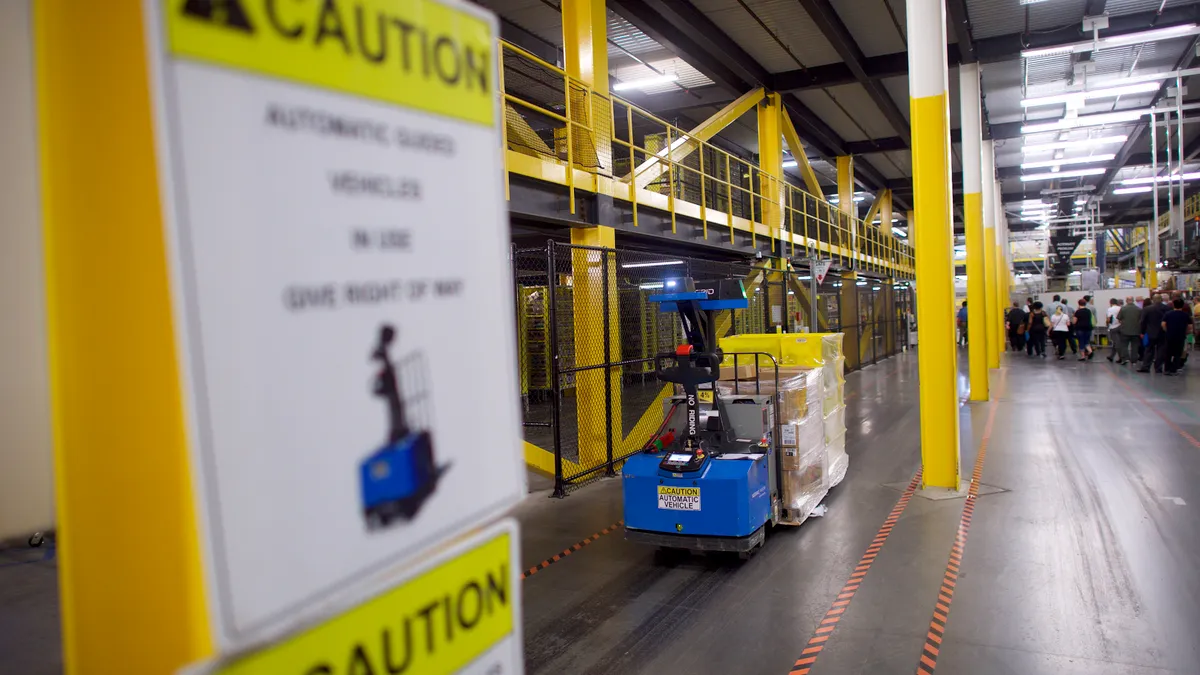Dive Brief:
- More and more businesses are turning to mobile robots for purposes such as warehouse automation, but obstacles such as cost concerns could weigh on the nascent market’s momentum, research firm Interact Analysis found in a recent survey.
- The lack of an available budget was ranked as the top barrier to mobile robot adoption, with a third of respondents reporting this as a challenge, according to a report on the findings published last month.
- “It’s not the cheapest technology, because it’s still relatively new,” Ash Sharma, chief commercial officer and vice president of research for robotics and warehouse automation at Interact Analysis, said in an interview. A major robot deployment aimed at fully equipping an entire warehouse could cost as much as $1 million on average, he said.
Dive Insight:
Mobile robots — machines that can move around on their own using sensors and other technology — are gaining popularity, with the market’s annual revenues projected to surpass $14 billion by 2027, up from $4.5 billion in 2023, according to a June report from Interact Analysis.
By 2027, 75% of companies will have adopted some form of “cyber-physical” technology, such as mobile robots, within their warehouse operations, Gartner predicted last year.
Sharma said Interact Analysis expects 200,000 mobile robots to be sold this year, up 25% compared to 2023. In 2027, the number of mobile robots sold is expected to reach about 700,000.
“This is still a relatively emerging technology if you compare it to say, industrial robot arms that are deployed in pretty much every factory around the world,” he said.
The upward trend in mobile robot sales is occurring as the overall warehouse automation market is struggling. Warehouse automation revenues are forecast to dip this year to $30.5 billion from $31.4 billion in 2023, according to Interact Analysis data shared with CFO Dive.
Interact Analysis’ latest research found that nearly six out of 10 companies are already using some form of mobile automation in their facilities.
Larger companies with revenues over $1 billion were more likely to use mobile robots than smaller ones. Most respondents (71%) said they only partially automated their workflows with mobile robots.
Mobile robots deliver a number of benefits by taking on some of the most labor-intensive warehouse jobs, according to a 2022 white paper from technology giant Honeywell International.
“These range from moving pallets, carts or totes full of goods to assisting human co-workers with pick and put operations,” the paper said. “While AMRs [autonomous mobile robots] handle these low-skilled, repetitive and often time-consuming jobs, increasingly scarce labor resources can be shifted to higher-value jobs.” Implementation of such machines can boost worker satisfaction while also reducing injuries and turnover rates, the report said.
Competition in the market has been heating up lately.
Earlier this year, Honeywell’s Intelligrated unit, which focuses on warehouse automation, announced a partnership with Chinese startup Hai Robotics, a provider of mobile robots.
Ontario, Canada-based Clearpath Robotics, another mobile robot maker, was acquired in 2023 by industrial automation and digital transformation company Rockwell.
Meanwhile, Amazon is among major warehouse operators that have invested heavily in automation technologies, including robots, in recent years.
Last October, Amazon announced a plan to begin testing a two-legged robot dubbed Digit for use in its warehouse operations. The robot was developed by Corvallis, Oregon-based Agility Robotics, one of the companies Amazon invested in through its $1 billion Industrial Innovation Fund as part of a decades-long push to invest in “next-generation technology” for its operations.
Companies that invest in mobile robots may need to wait two to three years on average to see a return on investment, according to Sharma.
“For some customers, that’s not quick enough,” Sharma said, adding that costs and ROI concerns are hindering adoption in some cases. For a large retailer like Amazon, adoption is “a necessity,” he said.
Interact Analysis conducted a global survey of 300 buyers and users of mobile robots, covering different company sizes, sectors and regions.













